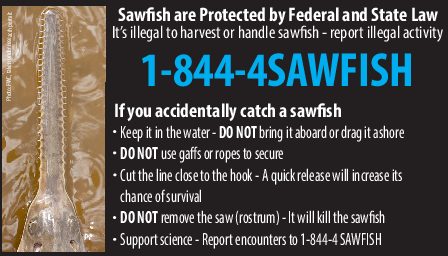General Practices
- Prepare to release fish on any trip and have the equipment to do so
- Learn to target particular species
- Use gear suited to size and species you are trying to catch
Specific Practices
Wet your hands prior to touching fish
Dry hands can damage the slime coat, which helps protect the fish’s skin and makes it easier for the fish to move underwater. Believe it or not, removing some of a fish’s slime coat can be fatal.
Minimize fight time when possible
Decreasing fight time decreases the amount of time the fish needs to recover and will also mitigate oxygen deficiency.
Remove hooks gently with pliers
Using a dehooking tool minimizes the chance of damaging the jaws during hook removal and also speeds up the dehooking process helping you get the fish back in the water quickly.
Use circle hooks when possible
Handle fish with lipping tool
Lipping tools allow anglers to easily restrain a slippery fish without causing bodily harm.
Support abdomen when lifting
Water normally supports a fish’s abdomen, be sure to support the abdomen when you lift fish out of the water to avoid organ damage.
Hold fish horizontally
Holding a fish vertically usually places all of the fish’s weight on their lip which can cause physical damage. In addition, fish rarely turn completely vertical on their own, as doing so can damage internal organs.
Return the fish to the water quickly
Fish exert a lot of energy and oxygen during a fight. Getting them back into the water quickly is key to their recovery.
Gently pull fish in a figure eight pattern prior to release
This allows oxygenated water to flow over its gills and helps fish recover, especially after a longer fight. Holding fish into a slight current is also a great way to accomplish this.
Deep-water Fish
What is barotrauma?
Deep-water sportfish often sustain pressure-related injuries during capture that are collectively known as “barotrauma.” Visible barotrauma symptoms commonly include stomach protrusion from the mouth, intestinal protrusion, bulging eyes, gas bubbles under the scales, and hard swim bladders. Such injuries are associated with bringing the fish to the surface rapidly from depth causing an overexpansion of the swim bladder and displacement of other vital organs. The effects of these injuries are highly variable and depth dependent. Fish exhibiting barotrauma symptoms may not be able to return to depth because of increased buoyancy associated with an overinflated swim bladder, making them easy targets for dolphins, sharks, and other large predators. As such, it is important to properly vent or use weighted descender tools to safely release fish and increase their chances of survival.
Fish Descending Devices:
Many deep-water fish, such as Red Snapper, are highly sought after sportfish that support large recreational fisheries. Although Red Snapper populations are steadily increasing, there are several obstacles facing anglers who wish to release non-legal snapper. Snapper have an organ called an air bladder which is used to control buoyancy. When snapper are brought up from depth this air expands and can lead to a series of complications collectively known as “barotrauma”. Any fish suffering from barotrauma is unlikely to survive release unless it returned to depth and recompressed. Research shows that simple descending devices like the Seaqualizer and the Shelton Fish Descender, can have a profound impact on the number of deep-water fish that survive release.
Inshore Fish
Use short leaders and fixed weights when bait fishing to reduce deep hooking.
If the fish is deep-hooked, cut the line as close to the hook as possible. The hook will eventually dissolve.
If you want to take pictures of your fish, try to leave them in the water. The chances of release mortality increase the longer the fish is out of water.
Tournament Angling
Avoid scheduling tournaments during the hottest times of the year, especially when water temperatures are above 85°F.
When transporting live fish in a live-well, be sure to provide at least 1.5 gallons of water per pound of fish.
Take care when using oxygen bottles, as too much oxygen can be fatal to the fish.
Exchange water at a rate of 10% per hour while providing constant aeration.
More information and instructional media will be available soon! Please check back often.
Are you planning a release tournament and have questions? Feel free to contact us!
Pelagics
Minimize fight time, studies show that exhaustion is one of the main contributors to post-release mortality in pelagic species.
Use circle hooks whenever possible.
Nylon leaders minimize physical injury to fish, decreasing mortality rates.
Only gaff fish you intend to keep.
More information and instructional media will be available soon! Please check back often.
Billfish
Use conventional circle hooks when targeting billfish. There has been a vast amount of research indicating that hook shape is one of the most important factors influencing billfish post-release mortality.
Limit drop-back time to reduce deep hooking.
Land fish quickly to minimize exhaustion and never remove them from the water.
More information and instructional media will be available soon! Please check back often.
Bycatch Species
Every angler will eventually catch a species that they are not targeting. These fish are known as bycatch and are often viewed as undesirable. Although these species are usually not prized, they do play an important role in the ecosystem and should be released with the same considerations as any sportfish.
Smalltooth Sawfish:
The now endangered Smalltooth Sawfish was once found from Texas to North Carolina. Habitat loss and historical bycatch mortality have reduced this species’ range to isolated portions of Florida.
These amazing fish can live 30 years and do not mature until 10 years of age. This slow reproductive strategy makes it very difficult for this species to recover.
Many agencies are working hard to understand if Sawfish still occur in other portions of their historic range. If you accidentally catch one, please follow the steps listed to ensure its safe release, and call 1-844-4SAWFISH .
More information is available here and at: www.SawfishRecovery.org.





